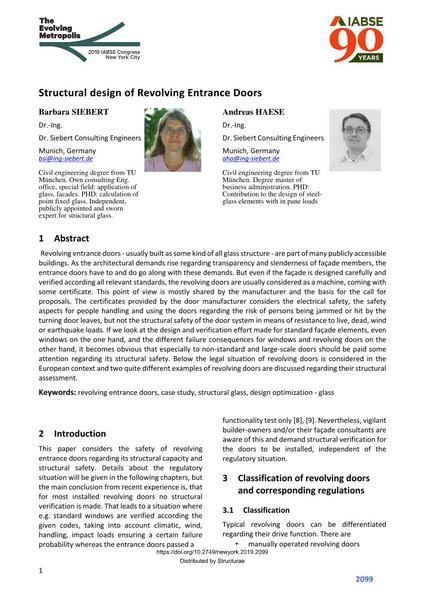Structural design of Revolving Entrance Doors

|
|
|||||||||||
Bibliografische Angaben
| Autor(en): |
Barbara Siebert
(Dr. Siebert Consulting Engineers)
Andreas Haese (Dr. Siebert Consulting Engineers) |
||||
|---|---|---|---|---|---|
| Medium: | Tagungsbeitrag | ||||
| Sprache(n): | Englisch | ||||
| Tagung: | IABSE Congress: The Evolving Metropolis, New York, NY, USA, 4-6 September 2019 | ||||
| Veröffentlicht in: | The Evolving Metropolis | ||||
|
|||||
| Seite(n): | 2099-2105 | ||||
| Anzahl der Seiten (im PDF): | 7 | ||||
| DOI: | 10.2749/newyork.2019.2099 | ||||
| Abstrakt: |
Revolving entrance doors - usually built as some kind of all glass structure - are part of many publicly accessible buildings. As the architectural demands rise regarding transparency and slenderness of façade members, the entrance doors have to and do go along with these demands. But even if the façade is designed carefully and verified according all relevant standards, the revolving doors are usually considered as a machine, coming with some certificate. This point of view is mostly shared by the manufacturer and the basis for the call for proposals. The certificates provided by the door manufacturer considers the electrical safety, the safety aspects for people handling and using the doors regarding the risk of persons being jammed or hit by the turning door leaves, but not the structural safety of the door system in means of resistance to live, dead, wind or earthquake loads. If we look at the design and verification effort made for standard façade elements, even windows on the one hand, and the different failure consequences for windows and revolving doors on the other hand, it becomes obvious that especially to non-standard and large-scale doors should be paid some attention regarding its structural safety. Below the legal situation of revolving doors is considered in the European context and two quite different examples of revolving doors are discussed regarding their structural assessment. |
||||
| Stichwörter: |
Fallstudie
|
||||
